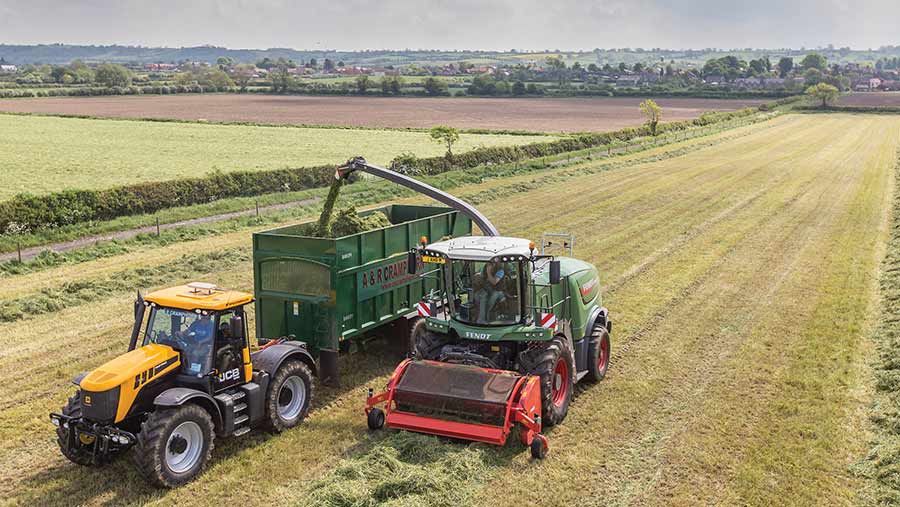How multi-cut can deliver profits of £333/ha over three-cut silage systems
 © Tim Scrivener
© Tim Scrivener Cutting grass more frequently can deliver better-quality forage capable of delivering £333/ha profit above a traditional three-cut silage-making system.
Dairy nutritionists Volac compared a five-cut system to a three-cut system at a commercial dairy farm in Pembrokeshire, south-west Wales, last season.
The five-cut system saw the first cut taken in mid-April, with subsequent cuts taken at four- to six-week intervals thereafter until mid-September.
A second grass plot was cut three times; the first in mid-April, second cut was taken nine weeks later in June, followed by a third 12 weeks later in September.
See also: Q&A: Multi-cut silage advice
Researchers analysed yield and nutritional value, with results showing:
- Average crude protein in the five multi-cut samples was 16.7%, compared with just 13.9% across the traditional three-cut silages.
- D value in the multi-cut system was 3 units higher at 72.7 compared with silage from the conventional system, which averaged 69.7.
- ME averaged 11.4 across the five multi-cut samples, with silage from the three-cut system averaging 10.9 – which is 0.5ME lower.
- It is often believed traditional systems offer more bulk, but the trial showed the multi-cut system actually yielded 0.92t DM/ha more grass than the three-cut system.
How does it stack up financially?
Overall, the multi-cut system delivered an extra 18,582 ME/ha.
Volac’s silage microbiologist Dr Mark Legget, who carried out the trial, calculated this would deliver dairy farmers additional profits of £333/ha when deducting extra contracting costs (see workings box).
However, multi-cut isn’t without its risks. Cutting more frequently can put grass silage at greater risk of contamination from soil and slurry residue due to the shorter cutting intervals.
Overcoming risks
To assess how this could be minimised, Volac assessed how its silage inoculant could improve conservation by ensiling four cuts and leaving half untreated and using Ecosyl on the rest.
It observed:
- Untreated silage took longer to reach target pH on all four cuts (less than 10 days after ensiling pH ranged between 5.2 and 6.3 and after 90 days it was still between 4.5 and 5.9). The target is to reach <4.5 as soon as possible to restrict the activity of bad bacteria.
- Treated silage benefited from faster acidification with pH reaching 3.8 to 4.4 in less than 10 days and sitting between 3.7 and 4.1 more than 90 days later.
- Treated silage also had lower enterobacteria counts and butyric acid, which is associated with soil organisms and clostridia and which affects dry matter and energy losses.
- DM losses averaged 9.6% in untreated silage and 5.3% in treated.
Workings
- 5.3mj of ME produces one litre of milk
- Therefore, 18,582 ME has the potential to deliver 3,506 extra litres/ha (18,582/5.3)
- This would equate to £877/ha at a milk price of 25p (3,506 x 0.25)
- Deducting contractor costs of £544/ha (includes fertiliser and slurry application, grass cutting, raking, tedding and clamping) this would leave the farmer with £333/ha.
Reaping the benefits
Farmers can only realise the true benefits of multi-cut silage if they ensure grass leys are in good order.
This was the message from Germinal’s Ben Wixey, who said he was encouraged by anecdotal feedback from dairy farmers, who said they were reseeding 8-10% of grassland annually.
National figures suggest just 2% of grassland is reseeded yearly and he reckons this figure is woefully low.
At Germinal’s Melksham research station in Wiltshire, trials demonstrated modern perennial ryegrasses consistently outyielded common weed grasses.
Yield comparisons made during second cut showed Aber grassed “romped ahead”, growing between 4.5t/DM/ha and 5.76t/DM/ha, whereas weed grasses trailed behind, yielding as little as 0.8t/DM/ha.
